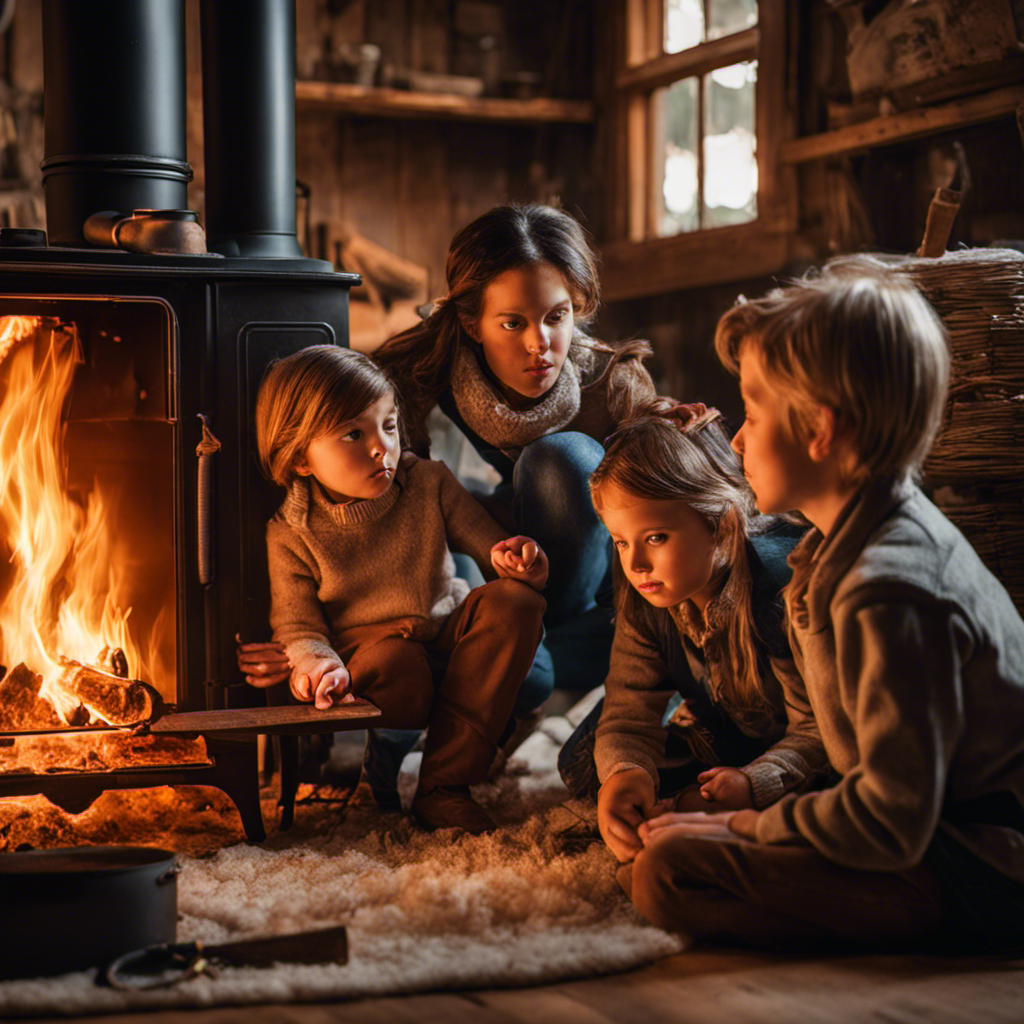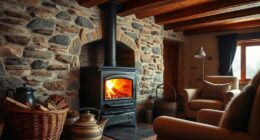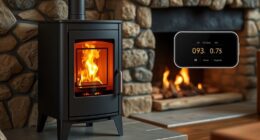As someone who has experienced the panic and fear of a wood stove fire, I know firsthand how crucial it is to be prepared. Contrary to popular belief, these fires can happen to anyone and can quickly turn into a dangerous situation.
In this article, I will share vital information on recognizing the signs of a wood stove fire, immediate steps to take, safe evacuation methods, and tips for prevention.
Stay informed and learn how to protect yourself and your loved ones in the event of a wood stove fire.
Key Takeaways
- Regular maintenance, including cleaning the chimney and flue, is crucial for preventing wood stove fires.
- Proper installation of the wood stove, following manufacturer’s instructions and using the correct type and size of chimney pipe, is important to avoid fire hazards.
- Close the air vents and assess the situation when discovering a wood stove fire, attempting to extinguish a small fire using a fire extinguisher designed for wood fires.
- Safely evacuate your home during a wood stove fire by installing smoke alarms, identifying exits, keeping fire extinguishers accessible, designating a meeting point, and practicing your evacuation plan regularly.
Recognizing the Signs of a Wood Stove Fire
I can easily recognize the signs of a wood stove fire. As someone who’s experienced the dangers of a wood stove fire firsthand, I’ve learned to be vigilant and aware of the warning signs.
There are several steps you can take to prevent wood stove fires and understanding the common causes can help you be proactive in avoiding them.
One of the most important steps to prevent wood stove fires is regular maintenance. Ensuring that your stove is cleaned and inspected annually by a professional is crucial. Creosote buildup, a common cause of wood stove fires, can be prevented by regularly cleaning the chimney and flue. Additionally, using dry and seasoned firewood can prevent excessive smoke and creosote buildup.
Another common cause of wood stove fires is improper installation. It’s important to follow the manufacturer’s instructions when installing a wood stove and to have it professionally installed if you’re unsure. This includes ensuring proper clearance from combustible materials and using the correct type and size of chimney pipe.
Immediate Steps to Take When Discovering a Wood Stove Fire
Upon discovering a fire in my wood stove, my first instinct is to immediately close the air vents to limit the oxygen supply. This is a crucial step to prevent the fire from spreading and gaining strength.
The next step is to carefully assess the situation. If the fire is small and contained within the stove, I can attempt to extinguish it using a fire extinguisher specifically designed for wood fires. It’s important to remember to aim at the base of the flames and sweep the extinguisher from side to side.
However, if the fire is larger or spreading beyond the stove, it’s essential to prioritize personal safety and evacuate the area immediately. In such cases, calling the fire department is the best course of action.
It’s vital to avoid using water to extinguish a wood stove fire, as it can cause a steam explosion and make the situation worse. Additionally, be cautious of potential hazards such as smoke inhalation and carbon monoxide poisoning. Therefore, it’s crucial to have working smoke detectors and carbon monoxide alarms installed and regularly maintained in your home.
How to Safely Evacuate Your Home During a Wood Stove Fire
During a fire, my top priority is to ensure the safety of myself and my loved ones by promptly evacuating our home. Having a well-thought-out evacuation plan can make all the difference in a time of crisis. Here are some safety precautions and steps to consider when creating your own evacuation plan:
| Safety Precautions | Evacuation Plan |
|---|---|
| Install smoke alarms on every level of your home and test them regularly. | Identify at least two exits from each room in your house. |
| Keep fire extinguishers in easily accessible areas, such as near exits. | Designate a meeting point outside your home where everyone can gather. |
| Teach everyone in your household how to use a fire extinguisher and when to evacuate. | Practice your evacuation plan regularly with your family. |
| Create a list of emergency contacts and keep it in a visible place. | Make sure everyone knows how to call emergency services. |
| Have a bag with essential items like identification documents, medication, and clothing ready to grab in case of an emergency. | Assign someone to assist children, elderly, or disabled family members during the evacuation. |
Using Fire Extinguishers to Suppress a Wood Stove Fire
Having a clear understanding of how to use a fire extinguisher effectively can be crucial in suppressing a fire and preventing it from spreading further. When it comes to wood stove fires, it’s important to choose the right type of fire extinguisher. For these types of fires, it’s recommended to use a Class A fire extinguisher, which is designed to tackle fires involving ordinary combustible materials like wood. Make sure to read the instructions on the fire extinguisher and familiarize yourself with its usage before an emergency occurs.
To effectively use a fire extinguisher on a wood stove fire, remember the acronym PASS: Pull, Aim, Squeeze, and Sweep. First, pull the pin to unlock the extinguisher. Next, aim the nozzle at the base of the fire, not at the flames. Squeeze the handle to discharge the extinguishing agent, and sweep the nozzle from side to side to cover the entire fire area.
Once the fire is extinguished, it’s important to take certain steps to ensure safety. First, carefully monitor the area to make sure the fire doesn’t reignite. Ventilate the room by opening windows and doors to let out the smoke. Check for any hot spots or embers that may still be smoldering and take appropriate action. Finally, it’s essential to have the wood stove and chimney professionally inspected and cleaned to prevent future fires.
Understanding how to use a fire extinguisher and taking the necessary steps after extinguishing a wood stove fire can help protect your home and loved ones. Stay prepared and stay safe.
Preventing Wood Stove Fires: Maintenance and Safety Tips
I find it crucial to regularly inspect and clean my wood stove and chimney to prevent any potential fire hazards. Taking proactive measures for wood stove fire prevention is essential for the safety of my home and family.
Here are some common causes of wood stove fires that I always keep in mind:
-
Creosote buildup: Creosote is a flammable substance that accumulates in the chimney when wood is burned. Regular cleaning helps to remove this buildup, reducing the risk of a chimney fire.
-
Improper installation: Ensuring that the wood stove is installed correctly is vital. It should be placed on a non-combustible floor, with proper clearance from walls and other flammable materials.
-
Overloading the stove: Overloading the stove with too much wood can cause it to overheat and potentially ignite nearby combustibles. I always follow the manufacturer’s guidelines for maximum wood load to prevent this from happening.
Emergency Contacts and Resources for Wood Stove Fire Situations
When a fire occurs, it’s important to have a list of contacts and resources readily available to assist in managing the situation. In case of a wood stove fire, there are several key contacts and resources that can help alleviate the situation and ensure the safety of everyone involved.
First and foremost, emergency services should be contacted immediately. Dial your local emergency number to notify the fire department and request assistance. They’re trained professionals who can quickly respond to the fire and provide the necessary help.
In addition to emergency services, there are fire safety organizations that can be contacted for guidance and support during a wood stove fire. These organizations have expertise in fire safety and prevention and can offer valuable advice on how to manage the situation and minimize the damage.
It’s a good idea to have the contact information for these emergency services and fire safety organizations easily accessible, such as saved in your phone or written down in a prominent location. This way, you can quickly reach out to them if a wood stove fire occurs.
Frequently Asked Questions
What Are the Common Causes of Wood Stove Fires?
Wood stove fires can be caused by a variety of factors. Lack of wood stove maintenance is a common cause, such as failing to clean the chimney regularly or not properly disposing of ashes.
Ignoring common safety precautions, such as using the wrong type of fuel or leaving the stove unattended, can also lead to fires.
It’s important to prioritize regular maintenance and follow safety guidelines to prevent wood stove fires.
How Often Should a Wood Stove Be Inspected for Safety?
Regular maintenance is crucial for the safety of wood stoves. Just like a car needs regular tune-ups to keep running smoothly, wood stoves require inspections to ensure they’re functioning properly.
So, how often should a wood stove be inspected for safety? Experts recommend an annual inspection by a qualified professional. This helps identify any potential issues or hazards, allowing for prompt repairs and ensuring your wood stove is in top-notch condition.
Stay safe and keep those fires burning responsibly!
Can a Wood Stove Fire Spread to Other Parts of the House?
Yes, a wood stove fire can spread to other parts of the house if not properly contained.
To prevent this, it’s important to have a fireproof barrier around the stove and ensure that there are no flammable materials nearby.
Regular maintenance and inspections of the stove are also crucial to identify any potential fire hazards.
Additionally, having smoke detectors and fire extinguishers in the house can help in case of an emergency.
Are There Any Specific Measures to Prevent Wood Stove Fires During Extreme Weather Conditions?
During extreme weather conditions, there are specific measures to prevent wood stove fires.
It’s important to regularly clean and maintain the stove, ensuring that there are no flammable materials nearby.
Additionally, installing a spark arrester on the chimney can prevent sparks from igniting nearby structures.
It’s also crucial to have emergency measures in place, such as having a fire extinguisher nearby and knowing how to use it.
Regularly reviewing and practicing your emergency plan can help ensure everyone’s safety.
What Should Be Done if Someone Gets Injured During a Wood Stove Fire?
What should I do if someone gets injured during a wood stove fire?
In case of an emergency, the first priority is emergency first aid. It’s crucial to assess the situation and determine the severity of the injuries. Apply basic first aid techniques like stopping bleeding, treating burns, and ensuring the person’s airway is clear.
Once the immediate threats have been addressed, it’s important to seek medical help as soon as possible to ensure proper care and treatment.
Conclusion
In the face of a wood stove fire, being prepared and knowing what to do can make all the difference. By recognizing the signs, taking immediate action, and safely evacuating your home, you can protect yourself and your loved ones.
Remember to have fire extinguishers on hand and regularly maintain your wood stove to prevent fires from happening in the first place.
Stay informed, stay safe, and be ready to handle any emergency situation that comes your way.





